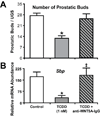WNT5A selectively inhibits mouse ventral prostate development
- PMID: 18804104
- PMCID: PMC2644641
- DOI: 10.1016/j.ydbio.2008.08.018
WNT5A selectively inhibits mouse ventral prostate development
Abstract
The establishment of prostatic budding patterns occurs early in prostate development but mechanisms responsible for this event are poorly understood. We investigated the role of WNT5A in patterning prostatic buds as they emerge from the fetal mouse urogenital sinus (UGS). Wnt5a mRNA was expressed in UGS mesenchyme during budding and was focally up-regulated as buds emerged from the anterior, dorsolateral, and ventral UGS regions. We observed abnormal UGS morphology and prostatic bud patterns in Wnt5a null male fetuses, demonstrated that prostatic bud number was decreased by recombinant mouse WNT5A protein during wild type UGS morphogenesis in vitro, and showed that ventral prostate development was selectively impaired when these WNT5A-treated UGSs were grafted under under kidney capsules of immunodeficient mice and grown for 28 d. Moreover, a WNT5A inhibitory antibody, added to UGS organ culture media, rescued prostatic budding from inhibition by a ventral prostatic bud inhibitor, 2,3,8,7-tetrachlorodibenzo-p-dioxin, and restored ventral prostate morphogenesis when these tissues were grafted under immunodeficient mouse kidney capsules and grown for 28 d. These results suggest that WNT5A participates in prostatic bud patterning by restricting mouse ventral prostate development.
Figures






References
-
- Benedict JC, Lin TM, Loeffler IK, Peterson RE, Flaws JA. Physiological role of the aryl hydrocarbon receptor in mouse ovary development. Toxicol Sci. 2000;56:382–388. - PubMed
-
- Castelo-Branco G, Sousa KM, Bryja V, Pinto L, Wagner J, Arenas E. Ventral midbrain glia express region-specific transcription factors and regulate dopaminergic neurogenesis through Wnt-5a secretion. Mol Cell Neurosci. 2006;31:251–262. - PubMed
-
- Cheng CW, Yeh JC, Fan TP, Smith SK, Charnock-Jones DS. Wnt5a-mediated non-canonical Wnt signalling regulates human endothelial cell proliferation and migration. Biochem Biophys Res Commun. 2008;365:285–290. - PubMed
-
- Cunha GR, Chung LW. Stromal-epithelial interactions--I. Induction of prostatic phenotype in urothelium of testicular feminized (Tfm/y) mice. J Steroid Biochem. 1981;14:1317–1324. - PubMed
Publication types
MeSH terms
Substances
Grants and funding
LinkOut - more resources
Full Text Sources
Molecular Biology Databases

